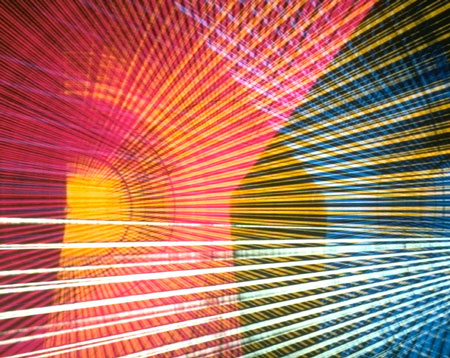Program Details
#3 (1994, 16mm, color, silent, 4 min.))
“#3 is a film with pure light, in which the images were created by recording the movements of a tiny light source with extremely long exposures, so that it draws traces on the emulsion. The light is part of a simple mechanical system that exhibits chaotic behaviour.” (JR)
#11, Marey <->Moiré (1999, 35mm scope, color, sound, 21 min.))
In the award-winning #11, Marey <->Moiré , Rekveld creates stroboscopic patterns from filaments of intersecting lights. “#11 is a film in which all images were generated by intermittently recording the movement of a line. It is a film about the discontinuity that lies at the heart of the film medium…#11 premiered at the Rotterdam International Film Festival in 2000. It won the Grand Prix for non-narrative animation at the Holland Animation festival in Utrecht in 2000. Also I’ve been told it was the first ever Dutch film to be shown at Sundance (also in 2000).” (JR)
#23.2, Book of Mirrors (2002, 35mm academy, color, sound, 12 min.))
Made in close collaboration with the composer Rozalie Hirs, the composition of #23 is based on symmetries and inversions. “The film was made with a set-up in which I use elementary optical principles to generate images. These images are caused by the interplay of light waves directly onto the emulsion, not using lenses as they are used normally to reproduce a scene outside of the camera. In that way I try to explore alternative forms of spatiality not related to traditional pictorial perspective.” (JR)
#37 (2009, 35mm scope, color, sound, 31 min.)
Rekveld’s latest film generates swarming tessellations from software exploring the organic symmetries of crystals. “Many pre-modern theories consider crystals as an intermediate form between the mineral, vegetative and animal kingdoms, an idea that acquires new resonances in the light of recent developments in the fields of artificial chemistry and artificial life. These new fields, with their hypothetical universes and ‘what-if’ scenarios, explore a kind of simulation that is far beyond the kind of photo-realistic simulations seen in many industrial computer animations. They have aspects in common with the way early abstract painters, filmmakers and light artists were developing a language to express hitherto unexpressable aspects of the universe through direct sensual experience.” (JR)
